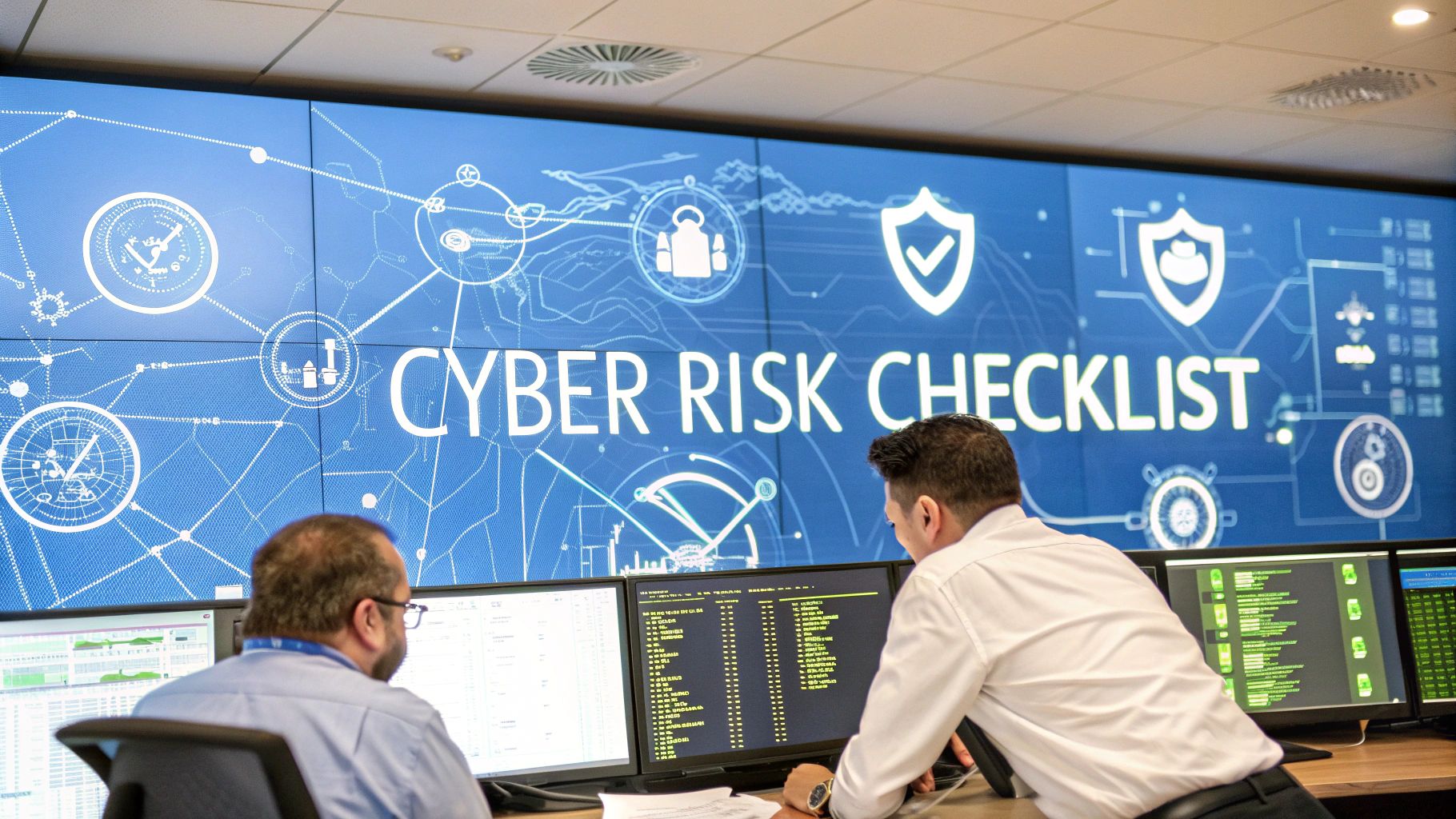A cybersecurity risk assessment can feel like a huge task. But for Managed Service Providers (MSPs), vCISOs, and GRC companies, it's the bedrock of protecting your clients. Think of it as creating a map that shows you exactly where the security weak spots are, so you can fix them before a real problem happens. This map is also what you'll need to show for compliance audits like SOC 2, HIPAA, or ISO 27001.
This cybersecurity risk assessment checklist breaks down the entire process into simple, easy-to-follow steps. It’s designed to help you make smart decisions, spend your security budget wisely, and build trust with your clients by proving you’ve done your homework. Let's get started on building a stronger defense against today's cyber threats.
Identifying and Cataloging All Your Digital Assets
Your cybersecurity risk assessment checklist must begin with a simple rule: you can't protect what you don't know you have. Asset identification is the process of making a complete list of every piece of hardware, software, and data in your IT environment. It's more than just listing computers; it's about creating a full inventory of anything an attacker might target.

Think about the big Equifax breach. Attackers got in through a server that wasn't on their inventory list, so it never got patched. A good inventory is the foundation of any security plan. For MSPs and vCISOs, managing this for multiple clients is key to providing real security and meeting compliance for frameworks like SOC 2 and HIPAA. An incomplete list leaves dangerous blind spots.
To do this right, use automated tools to scan your networks and find everything connected. Assign an owner to every asset—someone responsible for its security. Then, classify each asset based on how important it is. A server holding customer data is more critical than a marketing laptop, so it needs stronger protection.
Understanding the Cyber Threats You Actually Face
Once you have your asset list, the next step in your cybersecurity risk assessment checklist is figuring out who might attack them and how. This is called threat identification. It's about moving past the general idea of "hackers" and building a specific profile of the real threats your clients face.

The SolarWinds attack is a perfect example. Hackers attacked a software company to get into thousands of other businesses, including government agencies. This shows that threats can come from unexpected places. A proper risk assessment means looking at both your own weaknesses and the dangers from the outside world.
Knowing your vulnerabilities isn't enough; you need to know which threats are most likely to exploit them. This helps you focus your defenses where they matter most. For an MSP or vCISO, showing you understand industry-specific threats—like ransomware for hospitals—builds trust and helps meet compliance for PCI DSS or ISO 27001. A good way to start is by using the MITRE ATT&CK framework, which acts like an encyclopedia of hacker techniques.
Finding and Assessing Your Security Vulnerabilities
Now that you know what you have and who might attack it, your cybersecurity risk assessment checklist needs to find the weak spots. Vulnerability assessment is the process of scanning your systems, networks, and software to find security holes that attackers could use. It's about being proactive and finding problems before they do.

Remember the WannaCry ransomware attack? It spread like wildfire by exploiting a known weakness in Windows systems that many companies hadn't patched. This proves that regularly scanning for vulnerabilities and fixing them quickly is a must. Continuous scanning is a key part of any modern risk assessment strategy.
Ignoring vulnerabilities is like leaving your client’s front door unlocked. Attackers are always scanning for easy targets. As an MSP or vCISO, having a strong vulnerability management process is essential for client trust and meeting compliance rules for PCI DSS or HIPAA. Use tools to run automated scans, but don't just rely on the score. Prioritize fixes based on how critical the asset is and whether hackers are actively using that vulnerability. For more info, check out our guide on security vulnerability scanning.
Reviewing Your User Access and Identity Controls
A complete cybersecurity risk assessment checklist has to ask: who has access to what? An access control review looks at how you give users permission to access your digital resources. The goal is to make sure everyone has only the access they absolutely need to do their job—and nothing more. This is called the principle of least privilege.

The 2020 Twitter hack happened because attackers got access to internal tools with powerful permissions. It shows that weak internal controls can cause a disaster, even if your network perimeter is strong. A good review will find and fix issues like old accounts that are still active or people having way more access than they need.
Weak access control is a major cause of data breaches. For MSPs and vCISOs, managing user permissions across many clients is tough but vital for meeting compliance for HIPAA, PCI DSS, and SOC 2. The first and most important step is to turn on multi-factor authentication (MFA) everywhere you can. Then, regularly review who has access to what and remove permissions that are no longer needed.
Assessing Your Data Protection and Classification Methods
Your cybersecurity risk assessment checklist must also focus on how you protect your most valuable asset: data. This step involves finding where your sensitive data is, classifying it based on how important it is, and making sure it's protected. This includes data stored on servers, moving across the network, and being used on computers.
British Airways was fined millions for a data breach because they didn't have strong enough security protecting customer information. A proper data protection assessment helps you find your "crown jewels" and put the right safeguards in place to prevent a similar disaster. This is especially important for meeting compliance with data privacy laws.
For vCISOs and MSPs, proving that your client is taking good care of their data is a big part of achieving certifications like SOC 2. Start with a simple classification system, like Public, Internal, and Confidential. Use tools to find sensitive data you might not know about, and make sure everything marked "Confidential" is encrypted. Don't forget to test your backups regularly—a backup that can't be restored is worthless.
Reviewing Your Entire Network Security Design
A good cybersecurity risk assessment checklist digs into how your network is built. A network security architecture review checks the design of your infrastructure to make sure it can stop an attacker from moving around freely if they get inside. This means looking at firewalls, network segmentation, and how different systems talk to each other.
The infamous Target breach happened because attackers got in through an HVAC vendor and then moved easily from that network to the payment card system. If the network had been properly segmented—or divided into secure zones—the breach would have been contained. This shows how a bad network design can turn a small problem into a huge one.
Your network is the backbone of your IT environment. If its design is weak, everything connected to it is at risk. For MSPs and vCISOs, checking a client's network segmentation is crucial for protecting their most important assets and meeting compliance rules like PCI DSS, which requires isolating sensitive data. One of the best ways to do this is to adopt a "Zero Trust" mindset, which means you never trust any connection without verifying it first, even if it's coming from inside the network.
Checking Your Security Monitoring and Incident Response
What happens when an attack gets through your defenses? This question is a vital part of any cybersecurity risk assessment checklist. Assessing your security monitoring and incident response plan means checking if you can spot an attack quickly, contain the damage, and recover. It's not just about having the right tools; it's about having a clear, practiced plan.
The Sony Pictures hack was so bad because attackers were inside their network for a long time before anyone noticed. A slow response allowed them to cause massive damage. You can't just hope prevention will work 100% of the time. Your ability to respond quickly determines if an incident is a minor blip or a major disaster.
For MSPs and vCISOs, showing a client has a solid incident response plan is a requirement for compliance frameworks like SOC 2. A great way to prepare is to create "playbooks" for common attacks like ransomware. Then, run tabletop exercises where you walk through the plan with key team members. This practice is just as important as the plan itself.
Assessing Your Third-Party and Supply Chain Risks
A modern cybersecurity risk assessment checklist has to look beyond your own walls. A third-party risk assessment means checking the security of your vendors and partners who have access to your data or systems. Your security is only as strong as the weakest link in your supply chain.
The SolarWinds attack showed just how dangerous supply chain risk can be. Attackers often target smaller, less secure partners to find a backdoor into their real target. Ignoring the security of your vendors leaves a huge blind spot in your defenses.
For MSPs and vCISOs, managing this risk is a big part of the job and a key requirement for compliance frameworks like SOC 2 and PCI DSS. Start by ranking your vendors based on how much access they have. A payment processor needs a much tougher security review than your office supply company. Make sure your contracts require vendors to meet your security standards and notify you immediately if they have a breach. For more on this, read about building a third-party risk management process.
Turn Your Checklist into Action with a True Partner
Going through this cybersecurity risk assessment checklist gives you a clear map of your client's security posture. But a map only shows you where the problems might be. The next step is to confirm those weaknesses and find out if they can actually be exploited by an attacker. That's where penetration testing comes in.
A pentest is like hiring a friendly hacker to test your defenses. It validates your risk assessment findings and gives you a clear, prioritized list of what to fix first. This is often required for compliance with SOC 2, PCI DSS, and HIPAA. The problem is, the pentesting industry is broken for the channel. Most pentesting companies are too expensive, too slow, and will try to sell services directly to your clients.
We are the affordable alternative, built exclusively for partners like you. We are a channel-only company, which means we never compete with our MSP and vCISO clients. Our expert pentesters—certified with OSCP, CEH, and CREST—deliver fast, affordable, and high-quality manual pentesting. We provide white label pentesting reports that you can brand as your own, helping you strengthen client relationships and grow your business.
Ready to validate your risk assessment with a pentest that’s actually built for your business model? MSP Pentesting offers the affordable, manual, and white-labeled services you need. Contact us today to learn more about our reseller program and see how a true partner can help you succeed.


.avif)
.png)